The atmosphere of Mars was knocked into space by solar wind and radiation over a period of billions of years. The Red Planet used to be atmosphere-rich, warm, and wet with rain, oceans, rivers and lakes, say NASA scientists. It used to be much more similar to our life-friendly Earth than it is today.
Over billions of years, Mars lost most of its atmosphere in a process scientists call sputtering – which in lay terms means knocked into space.
When the Red Planet had a dense atmosphere, lots of water and Earth-like temperatures, it may have supported life as we know it.
In its current cold, dry and atmosphere-thin state, it has become a barren, desert world – a wasteland.
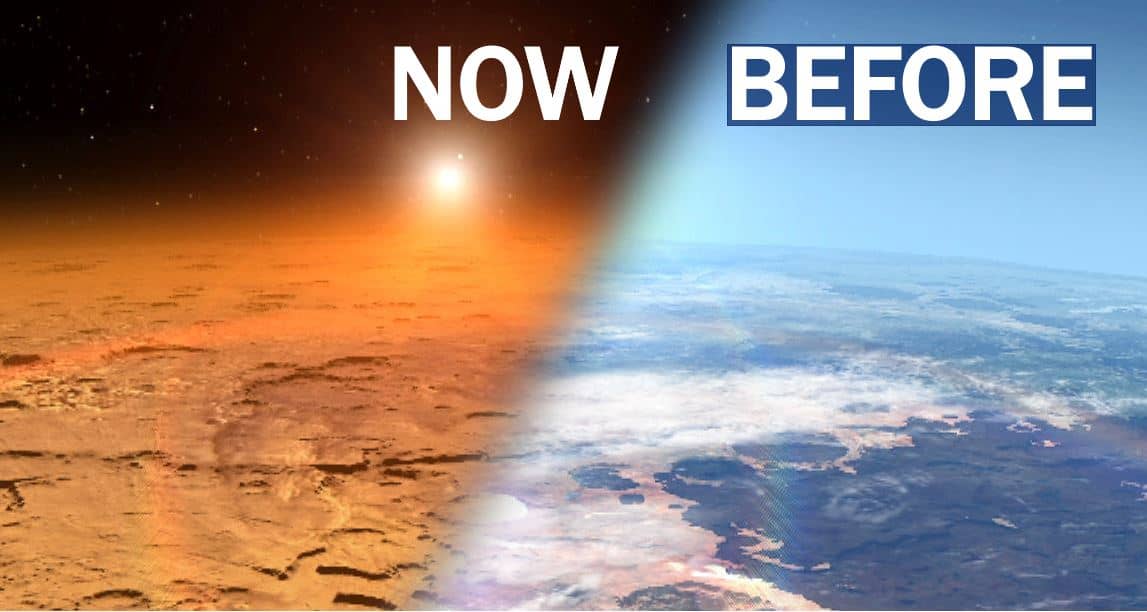 Mars was a very different place billions of years ago – it used to be more like Earth. In that warmer, wet, atmosphere-dense environment, did life emerge and thrive? If it did, will we ever find evidence – has any of it survived, perhaps underground? (Image: NASA’s Goddard Space Flight Center)
Mars was a very different place billions of years ago – it used to be more like Earth. In that warmer, wet, atmosphere-dense environment, did life emerge and thrive? If it did, will we ever find evidence – has any of it survived, perhaps underground? (Image: NASA’s Goddard Space Flight Center)
NASA came to this conclusion after gathering and examining information from the Mars Atmosphere and Volatile Evolution Mission (MAVEN), a spacecraft that orbits the Red Planet and is designed to study its atmosphere.
MAVEN’s mission includes trying to determine how Mars’ atmosphere and water, which we believe was once abundant, disappeared over time.
Mars lost much of its air
Head of the MAVEN team, Bruce Jakosky, who works at the University of Colorado in Boulder, said regarding the Red Planet’s atmosphere:
“We’ve determined that most of the gas ever present in the Mars atmosphere has been lost to space.”
Jakosky and co-authors of an article – ‘Mars’ atmospheric history derived from upper-atmosphere measurements of 38Ar/36Ar’ – published in the journal Science on March 31st, have estimated that about 65% of all Mars’ argon ended up being knocked into space.
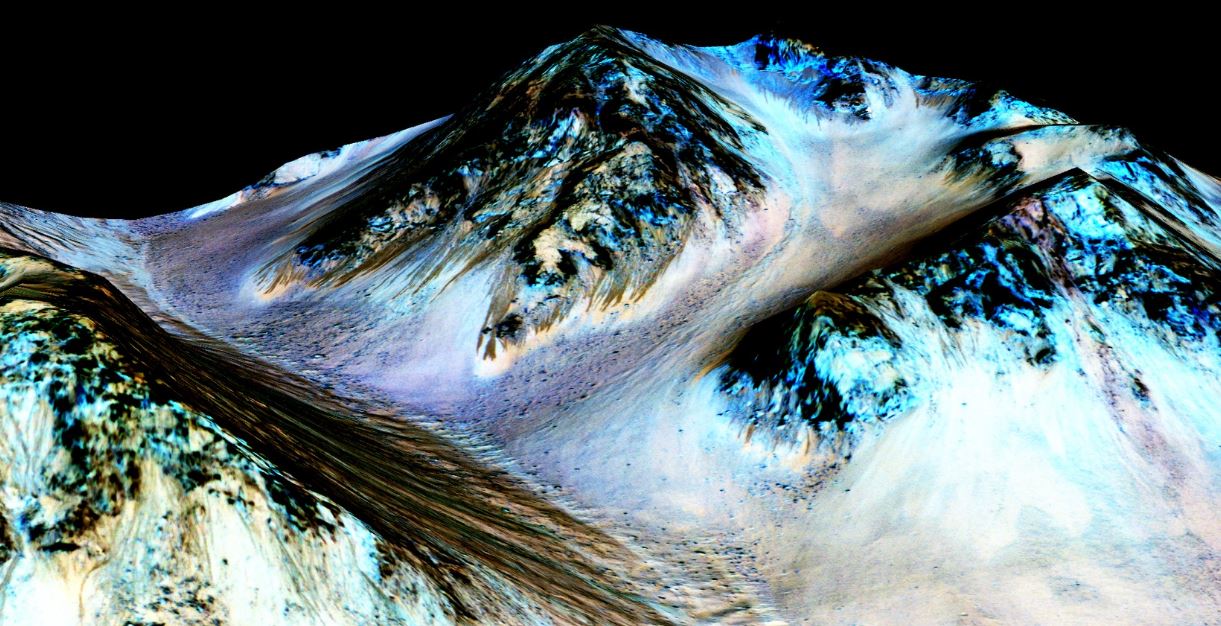 In September 2015, NASA confirmed evidence that liquid water flows on Mars’ surface today. According to NASA: “Researchers detected signatures of hydrated minerals on slopes where mysterious streaks are seen on the Red Planet. These darkish streaks appear to ebb and flow over time. They darken and appear to flow down steep slopes during warm seasons, and then fade in cooler seasons.” (Image: nasa.gov)
In September 2015, NASA confirmed evidence that liquid water flows on Mars’ surface today. According to NASA: “Researchers detected signatures of hydrated minerals on slopes where mysterious streaks are seen on the Red Planet. These darkish streaks appear to ebb and flow over time. They darken and appear to flow down steep slopes during warm seasons, and then fade in cooler seasons.” (Image: nasa.gov)
In an Abstract that describes the main article, the scientists wrote:
“A large fraction of Mars’ atmospheric gas has been lost to space, contributing to the transition in climate from an early, warm, wet environment to today’s cold, dry atmosphere.”
Mars once full of water
For life as we know it to exist, liquid water must be present on a planet’s surface. Water is not stable on the Red Planet’s surface, because its atmosphere is far too thin and cold to support it.
Scientists say there is evidence of minerals and dry riverbeds which could only have been formed if there had been lots of liquid water on the planet’s surface.
According to the MAVEN data, Mars used to be much more like Earth is today billions of years ago – a warm and wet world with a dense atmosphere. There were oceans, flowing rivers and lakes.
MAVEN Program Scientist, Elsayed Talaat, from NASA’s headquarters in Washington, explained:
“This discovery is a significant step toward unraveling the mystery of Mars’ past environments. In a broader context, this information teaches us about the processes that can change a planet’s habitability over time.”
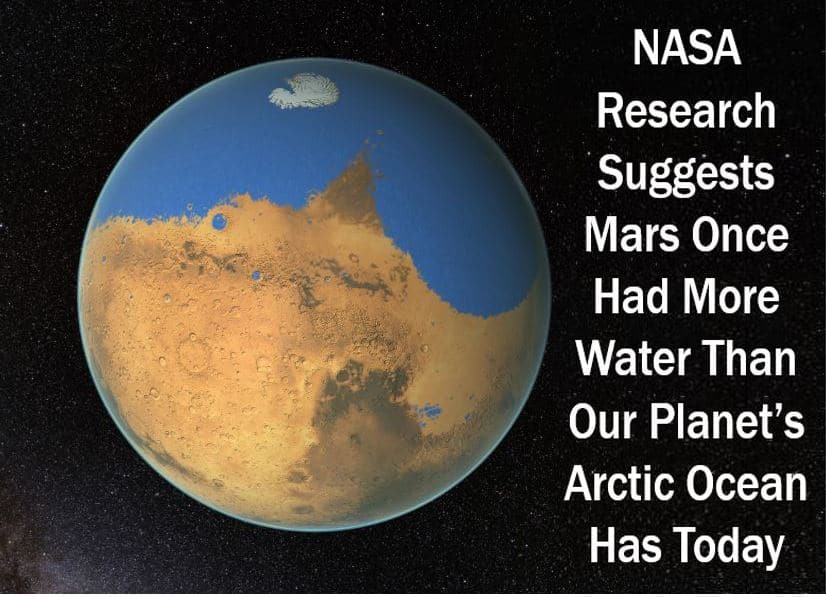 In March 2015, NASA scientists said that Mars most likely used to have a primitive ocean that held more water than our Arctic Ocean. The Red Planet lost about 87% of that water to space, they added. (Image: adapted from nasa.gov)
In March 2015, NASA scientists said that Mars most likely used to have a primitive ocean that held more water than our Arctic Ocean. The Red Planet lost about 87% of that water to space, they added. (Image: adapted from nasa.gov)
How did Mars lose its atmosphere?
Planets can lose their atmosphere through erosion by radiation, chemical reactions, and stellar winds from its parent star – Earth’s and Mars’ parent star is the Sun.
The latest MAVEN data shows that solar wind and radiation were responsible for the depletion of the Red Planet’s atmosphere.
Solar wind is a stream of electrically-conducting gas that continuously blows from the Sun’s surface.
Ultraviolet radiation from the Sun and solar wind used to be considerably more intense billions of years ago than they are today. The atmospheric loss due to these processes was significantly greater in Mars in the distant past.
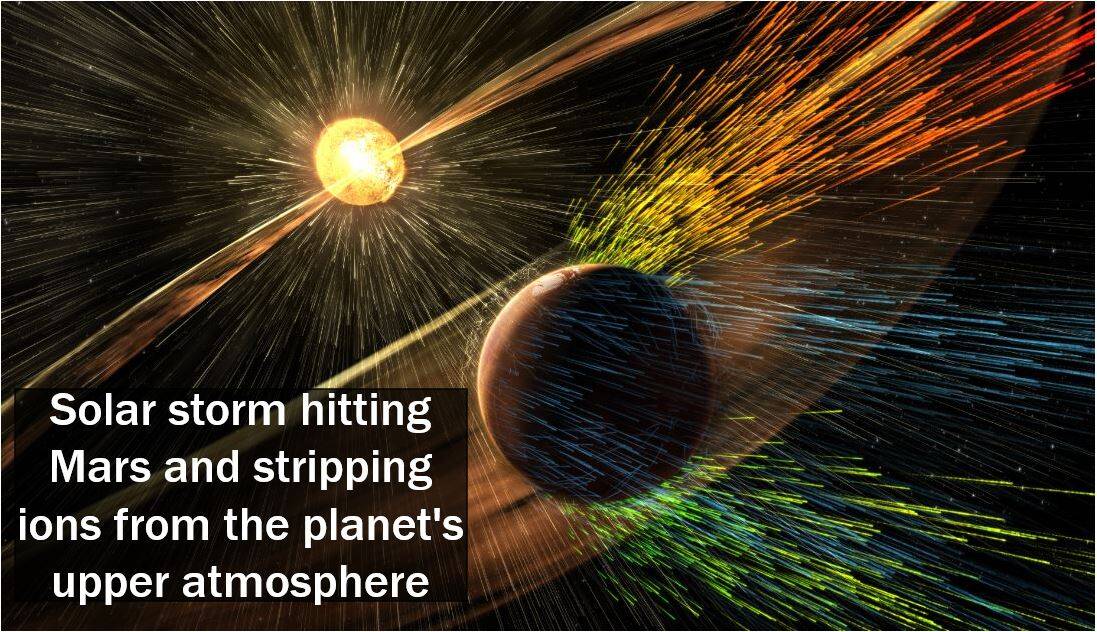 According to MAVEN data, solar wind has stripped away Martian gas at a rate of approximately 100 grams (1/4 pound) per second. Jakosky said: “Like the theft of a few coins from a cash register every day, the loss becomes significant over time. We’ve seen that the atmospheric erosion increases significantly during solar storms, so we think the loss rate was much higher billions of years ago when the sun was young and more active.” (Image: adapted from nasa gov)
According to MAVEN data, solar wind has stripped away Martian gas at a rate of approximately 100 grams (1/4 pound) per second. Jakosky said: “Like the theft of a few coins from a cash register every day, the loss becomes significant over time. We’ve seen that the atmospheric erosion increases significantly during solar storms, so we think the loss rate was much higher billions of years ago when the sun was young and more active.” (Image: adapted from nasa gov)
When Mars was a warm, atmosphere rich, wet planet, microbial life may have thrived there, scientists suggest. However, as temperatures declined and everything dried up, any life form (as we know it) would either have died, gone underground, or forced into rare surface oases.
The authors came to their current conclusion after measuring how abundant two different isotopes of argon gas were in the Martian atmosphere. Isotopes are atoms of the same element but with different mass.
The lighter isotope escapes into space more readily. That means that the air remaining behind will be richer in the heavier isotope.
Jakosky and colleagues used the two isotopes’ relative abundance on the Red Planet’s surface and upper atmosphere to determine how much of its atmospheric gas ended up in outer space.
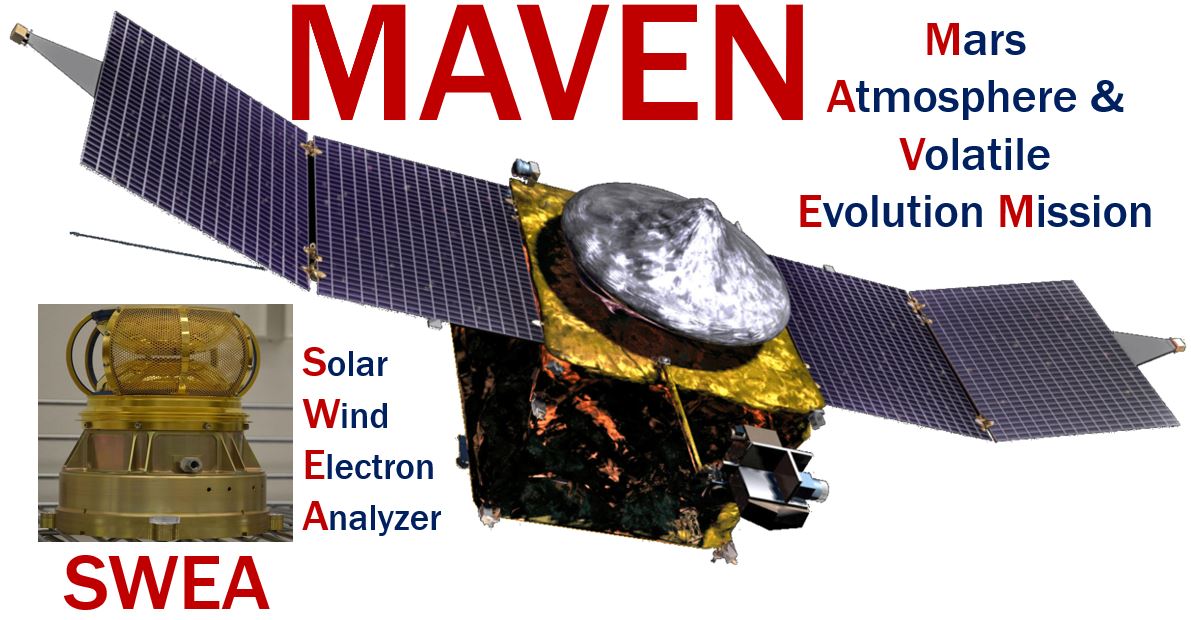 MAVEN orbits Mars. The space probe sends data to scientists on Earth regarding the Red Planet’s atmosphere. SWEA is a device fitted to MAVEN that measures solar wind and ionosphere electrons. (Images: 1. MAVEN – Wikipedia. 2. SWEA – Wikipedia)
MAVEN orbits Mars. The space probe sends data to scientists on Earth regarding the Red Planet’s atmosphere. SWEA is a device fitted to MAVEN that measures solar wind and ionosphere electrons. (Images: 1. MAVEN – Wikipedia. 2. SWEA – Wikipedia)
Argon – a noble gas
Noble gases (inert gases) – helium (He), argon (Ar), krypton (Kr0, xenon (Xe), neon (Ne) and radon (Rn) – make a group of chemical elements with similar properties. Under standard conditions they are colorless, odorless, monatomic (single-atom) gases with extremely low chemical reactivity.
Noble gases can’t be sequestered in rocks. The only way a noble gas can disappear is through ‘sputtering’. Sputtering is a process in which solar wind picks up ions and physically knocks the atmospheric gas into space.
In this latest study, the scientists tracked argon because it can only disappear from the atmosphere as a result of sputtering. After estimating how much argon had vanished, they could use this information to determine the sputtering loss of other gases, including CO2 (carbon dioxide).
CO2 retains heat and keeps a planet warm – it is an efficient greenhouse gas. Carbon dioxide is the atmosphere’s major constituent in Mars – hence the interest.
The scientists made this estimate using information from the upper and lower Martian atmosphere, which was gathered by MAVEN’s Neutral Gas and Ion Mass Spectrometer (NGIMS) and Curiosity’s Sample Analysis of Mars (SMA) instrument respectively.
Co-author Paul Mahaffy, from NASA’s Goddard Space Flight Center in Greenbelt, Maryland, explained:
“The combined measurements enable a better determination of how much Martian argon has been lost to space over billions of years. Using measurements from both platforms points to the value of having multiple missions that make complementary measurements.”
Video – Mars used to have more gas
As this Wochit News video explains, the Martian atmosphere definitely had considerably more gas in the past.
